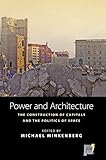Power and Architecture : The Construction of Capitals and the Politics of Space / ed. by Michael Minkenberg.
Material type: TextSeries: Space and Place ; 12Publisher: New York ; Oxford : Berghahn Books, [2014]Copyright date: ©2014Description: 1 online resource (320 p.)Content type:
TextSeries: Space and Place ; 12Publisher: New York ; Oxford : Berghahn Books, [2014]Copyright date: ©2014Description: 1 online resource (320 p.)Content type: - 9781782380092
- 9781782380108
- Architecture and state
- Capitals (Cities) -- Case studies
- City planning -- History
- Democracy and architecture
- Democracy
- National characteristics
- Power (Social sciences)
- Public architecture
- Public spaces -- Political aspects
- Symbolism in architecture
- ARCHITECTURE / Urban & Land Use Planning
- Urban Studies, History (General)
- 320.01/1 23
- online - DeGruyter
| Item type | Current library | Call number | URL | Status | Notes | Barcode | |
|---|---|---|---|---|---|---|---|
 eBook
eBook
|
Biblioteca "Angelicum" Pont. Univ. S.Tommaso d'Aquino Nuvola online | online - DeGruyter (Browse shelf(Opens below)) | Online access | Not for loan (Accesso limitato) | Accesso per gli utenti autorizzati / Access for authorized users | (dgr)9781782380108 |
Frontmatter -- Contents -- Acknowledgments -- Figures -- Maps -- Introduction. Power and Architecture Th e Construction of Capitals, the Politics of Space, and the Space of Politics -- Chapter 1. Capital Architecture and National Identity -- Chapter 2. A City of the People, by the People, for the People? Democracy and Capital-Building in Washington, DC, Ottawa, Canberra, and Brasília -- Chapter 3. Capital-Building in Post-War Germany -- Chapter 4. Berlin: Three Centuries as Capital -- Chapter 5. Image, Itinerary, and Identity in the “Third” Rome -- Chapter 6. “A Capital without a Nation”: Red Vienna, Architecture, and Spatial Politics between the World Wars -- Chapter 7. The Ruins of Socialism: Reconstruction and Destruction in Warsaw -- Chapter 8. State Building as an Urban Experience: The Making of Ankara -- Chapter 9. Building Capital Mindscapes for the European Union -- Contributors -- Index
restricted access online access with authorization star
http://purl.org/coar/access_right/c_16ec
Capital cities have been the seat of political power and central stage for their state’s political conflicts and rituals throughout the ages. In the modern era, they provide symbols for and confer meaning to the state, thereby contributing to the “invention” of the nation. Capitals capture the imagination of natives, visitors and outsiders alike, yet also express the outcomes of power struggles within the political systems in which they operate. This volume addresses the reciprocal relationships between identity, regime formation, urban planning, and public architecture in the Western world. It examines the role of urban design and architecture in expressing (or hiding) ideological beliefs and political agenda. Case studies include “old” capitals such as Rome, Vienna, Berlin and Warsaw; “new” ones such as Washington DC, Ottawa, Canberra, Ankara, Bonn, and Brasília; and the “European” capital Brussels. Each case reflects the authors’ different disciplinary backgrounds in architecture, history, political science, and urban studies, demonstrating the value of an interdisciplinary approach to studying cities.
Mode of access: Internet via World Wide Web.
In English.
Description based on online resource; title from PDF title page (publisher's Web site, viewed 25. Jun 2024)


